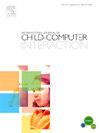The feasibility of an immersive interactive virtual reality task for children and adolescents.
Q1 Social Sciences
International Journal of Child-Computer Interaction
Pub Date : 2025-01-22
DOI:10.1016/j.ijcci.2025.100722
引用次数: 0
Abstract
The interest in using immersive Virtual Reality (hereafter referred to as VR) for clinical interventions in (mental) health care settings has been growing for adults, as well as adolescents and children. However, VR systems and evidence-based VR-software have not specifically been built for minors. To develop a potentially effective clinical VR intervention for children and adolescents, it is crucial to assess the motivation for and the feasibility of the VR software and the respective VR system first. This study assessed these aspects with regard to a self-developed interactive VR task that serves as a base for a clinical VR intervention in children and adolescents, using a Meta Quest 2 system. Feasibility was measured by assessing tolerability, usability, satisfaction, presence, and perceived realism. The relations between motivation and the different feasibility aspects were explored, and the associations between age, frequency of digital media use, and sex on the one hand and motivation and the five aspects of feasibility on the other were tested. A pre- and post-test design was implemented, using self-report questionnaires. 85 children aged 8–17 years participated (Mage = 10.55 years, SDage = 2.06 years), of which 31 (36%) were girls and 54 (64%) were boys. The VR task was found to be highly motivating and overall feasible for this age group, whereby the motivation and the feasibility did not vary based on age, frequency of digital media use, or sex. The results of this study indicate that this task could be a feasible base for a VR mental health intervention for children and adolescents aged 8–17 years using a Meta Quest 2 system, regardless of their sex or frequency of digital media use.
儿童和青少年沉浸式互动虚拟现实任务的可行性。
对于成年人、青少年和儿童来说,将沉浸式虚拟现实(以下简称VR)用于(精神)卫生保健环境中的临床干预的兴趣一直在增长。然而,VR系统和基于证据的VR软件并不是专门为未成年人打造的。为了开发一种潜在有效的儿童和青少年临床虚拟现实干预,首先评估虚拟现实软件和相应虚拟现实系统的动机和可行性至关重要。本研究使用Meta Quest 2系统,对自主开发的交互式VR任务进行了这些方面的评估,该任务可作为儿童和青少年临床VR干预的基础。可行性通过评估耐受性、可用性、满意度、存在感和感知的现实性来衡量。探讨了动机与不同可行性方面之间的关系,并测试了年龄、数字媒体使用频率和性别与动机和五个可行性方面之间的关系。采用自我报告问卷,进行了前后测试设计。85例8 ~ 17岁儿童(年龄10.55岁,年龄2.06岁),其中女孩31例(36%),男孩54例(64%)。研究发现,虚拟现实任务对这个年龄段的人来说是高度激励和整体可行的,因此,动机和可行性并不会因年龄、数字媒体使用频率或性别而变化。这项研究的结果表明,这项任务可以作为8-17岁儿童和青少年使用Meta Quest 2系统进行虚拟现实心理健康干预的可行基础,无论他们的性别或数字媒体使用频率如何。
本文章由计算机程序翻译,如有差异,请以英文原文为准。
求助全文
约1分钟内获得全文
求助全文
来源期刊

International Journal of Child-Computer Interaction
Social Sciences-Education
CiteScore
7.20
自引率
0.00%
发文量
73
 求助内容:
求助内容: 应助结果提醒方式:
应助结果提醒方式:


